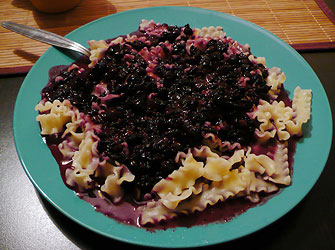Polish First Courses — top 27 first courses from Poland
Here comes a list of modern and traditional Polish first courses. Under their descriptions you can find some authentic recipes. Going to visit Poland? Would you like to taste some delicious foods not choosing on spec? You are welcome. All Polish foods listed below constitute a typical Polish menu even nowadays. Therefore, while visiting Poland, one will certainly come across many of them. I wish you good luck in exploring Polish tastes and… Smacznego!
Pierogi • Pierogi / Pierogies / Dumplings
in Polish: pierogi, pierożki (diminutive)
- ♒ Pierogi dough recipe
- ♒ Pierogi with meat filling recipe
- ♒ Pierogi or uszka with mushroom & cabbage recipe
- ♒ Recipe for uszka for the Christmas Eve clear borscht
- ♒ Pierogi with bil-, blue- or strawberries recipe
- ♒ Pierogi with white mushrooms and eggs recipe
The well-known Polish dumplings called pierogi are one of national dishes and for sure one of the best recognizable Polish foods. The popularity of pierogi probably originates from the fact that this Polish food is varied, with quite a few fillings. So we have not only ruskie pierogi (with cheese & potatoes; translation into English is Ruthenian pierogi, 'Russian' is incorrect!) which are well-known in the USA, but, let me be frank with you, they are not the most popular in Poland. In general, we have a whole gamut of tastes ;) For example, there are delicious pierogi with forcemeat, mushroom or cabbage. As a gourmand, I enjoy sweet pierogi with a filling made from a sweet curd cheese or fresh fruit like bilberries or strawberries. more
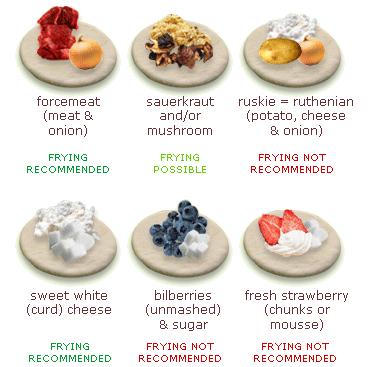
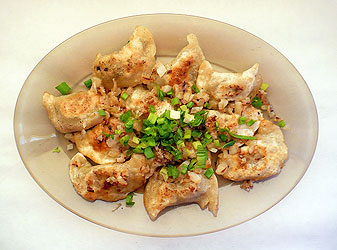
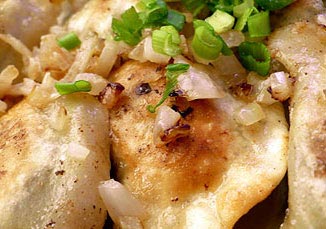
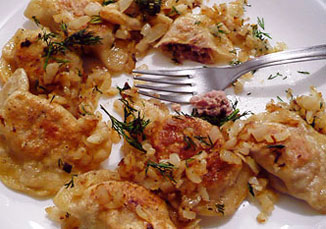
Bigos • Polish hunter's stew
in Polish: bigos
Bigos, in English language known as the Polish hunter's stew, is one of national and traditional Polish courses. A true touristic 'must eat'. Bigos is a stewed dish made from cabbage as a main ingredient. Fresh cabbage can be used as well as the soured one, called sauerkraut. Hence, more than one kind of bigos exists in the Polish cuisine. Since cooking bigos usually lasts two to four days, the delicious taste of this Polish food is something really original and different compared to what you are used to :) Apart from cabbage, on a list of ingredients you can also find: diced sausage, dried mushrooms, onion, sometimes apple or dried plums and a characteristic unchanging set of spices: bay leaf, grains of black pepper and allspice. White wine is sometimes added, but this is not a rule. Polish first course bigos is usually eaten with bread, only sometimes with potatoes. A slice of a good sausage can be also added. Bigos is also known in the Lithuanian cuisine.
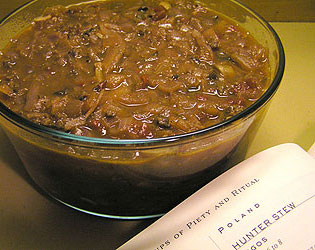
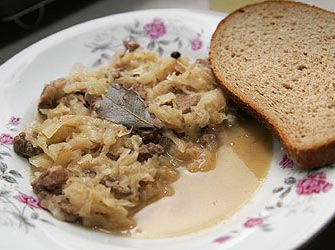
Photos by Laurel Fan (1) and Wikipedia (2).
Golabki • Polish cabbage rolls in tomato sauce
in Polish: gołąbki
Golabki or stuffed cabbage is one of a traditional food of Central and Eastern Europe. Polish golabki is a cooked knob of forcemeat wrapped up in a leaf of a white cabbage. Important ingredients are: groats (nowadays rice is much more popular), onion and an appropriate blend of spices. Sometimes mushrooms are added to the filling. Also some other variants of the filling exist in the traditional Polish cuisine, e.g. fowl, mutton or even with no meat at all (some vegetable-based golabki, but these are less common). This Polish food is stewed or fried before eating. When laid on plates golabki are poured over with a delicious dense home-made tomato sauce. Polish cabbage rolls are eaten with bread, sometimes with boiled potatoes. In the Czech Republic and Slovakia, stuffed cabbage is called holubce, in Germany the Krautwickel/Kohlrouladen. This great food is also known in Sweden where it is called the Kåldolmar.
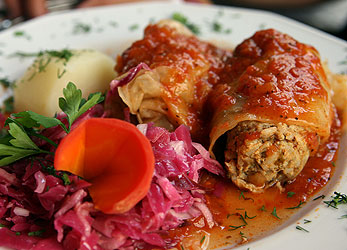
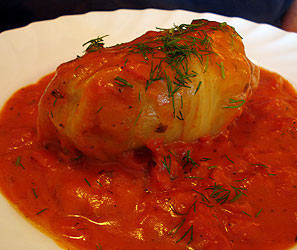
Kotlet schabowy • Polish pork schnitzel
in Polish: as above
Kotlet schabowy is a staple of Polish dinners. This Polish food is just a pork cutlet in a coating, dished up with potatoes (sometimes chips) and vegetables or a stewed shredded white cabbage bed. This is closely related with a schnitzel. The history of Polish kotlet schabowy dates back to the 19th century. The first written recipe attesting its existence can be found in a cookbook from 1860 by Lucyna Cwierczakiewiczowa.
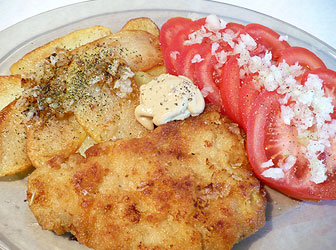
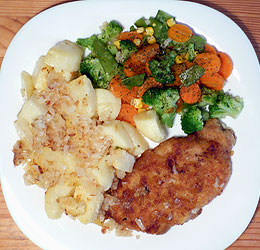
Kopytka • Hooves dumplings
in Polish: as above
Kopytka is a next kind of delicious Polish dumplings. I must admit that I love it. To experience a full magnificence of this Polish first course, it is important to learn how to concoct kopytka properly. In my life I had both poorly made and not so tasty kopytka and perfect one. These are characterized by a delicate taste and softness. Kopytka are served as a separate dish with pork scratching, fried onion, or as a side-dish for sauces (e.g. Polish goulash).
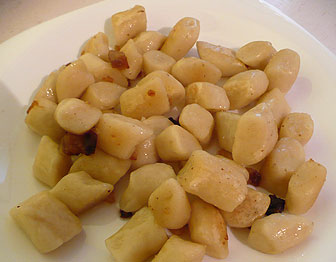
Kluski slaskie • Silesian dumplings
in Polish: kluski śląskie
Kluski slaskie are a special kind of potato dumplings. Silesian dumplings are characterized by their great softness and a delicate flavor. When well prepared, this Polish food almost melts in a mouth. Kluski slaskie are made from cooked potatoes and starch, and have the shape of a flattened ball with a characteristic hollow in the center. Kluski slaskie are eaten with meat sauces (in Silesia with a so-called Silesian meat roll (rolada slaska in Polish)) or separately, spiced up with molten smalec (lard) and some browned onion. Since it is possible to freeze Silesian dumplings losing neither quality nor taste, nowadays the majority of Polish families buy ready-made frozen kluski slaskie in grocery.
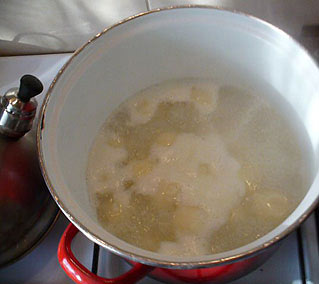
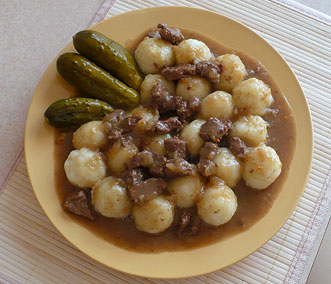
Kotlet mielony • Polish ground cutlet
in Polish: as above
Polish kotlet mielony is somehow similar to hamburger meat. This is a piece of fried minced meat (oftentimes pork neck is used), previously mixed with raw egg, onion fried in butter, garlic, breadcrumbs, parsley leaves and some spices added to taste. Quite a nice food but personally, I do not eat it very often. Polish ground cutlet, just like its more popular 'brother' kotlet schabowy, is served with potatoes and a vegetable salad. In case of ground cutlet potatoes can be replaced by groats. Oftentimes groats and cutlet are poured over with a beef sauce. Moreover, this Polish food is sometimes made from chicken, turkey, game or beef.
Placki ziemniaczane • Potato pancakes
in Polish: as above
Placki ziemniaczane is a Polish name for a quite well-known, simple and good food made from grated potatoes fried in a fat. Egg, onion and spices (pepper, salt, sometimes marjoram) are added to the potato mass before frying. In Poland placki ziemniaczane are a representative of a sweet dish (!), because this course is sprinkled with sugar or more rarely poured with some powidl, apple mousse or with sweet curd cheese chunks. the more refined and really wonderful version of this dish is the Polish dish called placek po zbojnicku (served with meat, sauce and vegetable salad; see below). Potato pancakes are an international dish. Some slightly different varieties are known in Czech Republic, Ukraine, Belarus, Germany, Switzerland (rösti – pretty wunderbar), Sweden, Romania, in Anglo-Saxon countries (hash browns), and in the Jewish cuisine.
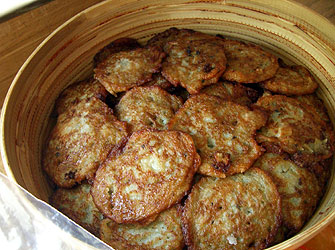
Placek po zbojnicku • Brigand's pancake
in Polish: placek po zbójnicku
Placek po zbojnicku is a refined version of Polish potato cakes (placki ziemniaczane). While placki ziemniaczane are small, here much bigger pancake are fried. Polish brigand's pancake is dished up with beef sauce and beef chunks, as well as a vegetable salad side dish. Some people like to pour ketchup over it.
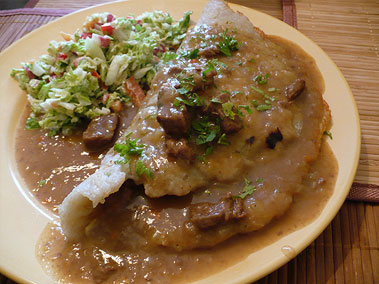
Golonka gotowana • Pork hock
in Polish: as above
Golonka gotowana is one of the Polish-German foods. In Germany it is known as a Schweinehaxe. Golonka gotowana is a chunk of a pig's leg cooked together with the bone. This piece of meat is served with sauce and vegetables.
Pyzy • Pyzy - Polish dumplings
in Polish: pyzy
Pyzy are peculiar Polish dumplings in a form of knobs. This Polish food is made from grated potatoes and often stuffed with meat. Pyzy are a very cheap and tasty dish. Some Polish people like to stir-fry them slightly. The Polish dish pyzy is usually eaten with pork scratching, some lard or fried onion, although it can also constitute an element of a bigger dish. In Greater Poland the word pyzy means pampuchy which are specific steamed dumplings filled with fruit (search below for their description).
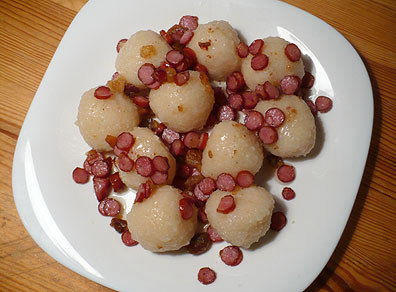
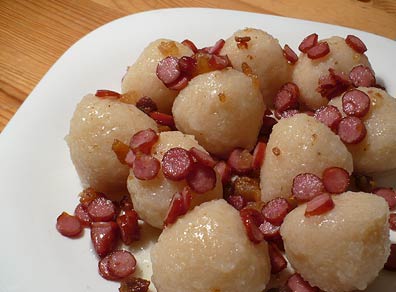
Zrazy • Beef rolls
in Polish: zrazy
Zrazy is an traditional Old Polish food coming from the Polish Gentry and the cuisine of hunters. Zrazy is made from slices of beef, veal or game, stir-fried and stewed with an addition of vegetables and spices. Oftentimes the slice of meat is rolled up and stuffed with one of many kinds of stuffing. Nowadays, this Polish food is well-known in cuisines of nations of the Polish-Lithuanian Commonwealth (18th century): Poland, Lithuania, Belarus and Ukraine. Similar dishes exist in other European traditions. Rinderroulade, bragioli or paupiette are such examples.
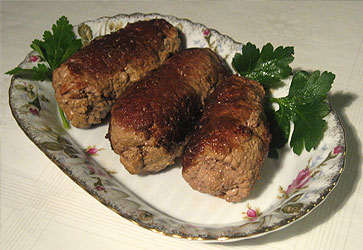
Ryba po grecku • Polish 'Greek fish' / Greek-style fish
in Polish: as above
Polish Greek-style fish is one of a completely marvelous originally Polish dish which, as a tradition in many Polish families, is a sure hit on the Christmas Eve table. It is ethnically Polish and to spite the name of this dish, Greeks do not have a slightest inkling about it. Nobody in Poland has ever been able to explain to me whence the name of the dish. Maybe several years ago a Pole had the idea of Greek-style fish recipe, and wanted to make it sound exotic and noble? Anyway, this is the most commo name for this dish.
What is interesting, the Polish Greek-style fish is often eaten cold, although this is not a rule. This Polish dish is made from fish filets fried in a coating. Next, fish is being arranged in a bowl together with a special, red-colored blend made from boiled vegetables. What we have got here is parsley, celery, onion, tomato concentrate, as well as some seasoning. But the main ingredient, a highlight is carrot. This unique Polish food is slightly sweet and quite aromatic.
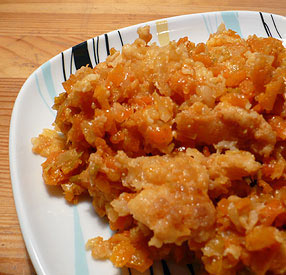
Kotlet de volaille • Chicken de volaille / Cutlet de volaille
in Polish: as above
Polish cutlet de volaille is a rolled chicken or turkey breast, fastened together with skewers and fried in a 'golden' coating. The word 'volaille' is French and it means 'poultry'. Inside this Polish food you can find some tidbits. Classically Polish volaille is filled with butter or herbal butter mixed with garlic and parsley. However, oftentimes volaille is stuffed with chopped up and stir-fried mushrooms, rolled up slices of hard cheese or stewed leaves of spinach. This tasty Polish first course is served with vegetables and chips / boiled potatoes.
Karp smazony • Fried carp
in Polish: karp smażony
Fried carp is one of national Polish foods, eaten only once a year - during the Christmas Eve supper. Depending on local and family traditions, carp is fried in a coating or without. More superstitious Poles believe that carp brings luck. For example, you can put a scale of the carp into your wallet. As a consequence, in the next year, you will have the best of luck in business.
Generally speaking, in Western countries carp is believed to be an inedible fish. Well, there is some truth in it. Nevertheless, in Poland carp is bred in special conditions, thanks to which the taste of the fish should not be sludgy and its meat should not stink. So, believe me that this festive fish is really nice when purchased from a reliable source. Moreover, before carp is being faced with a dramatic end of its existence, the fish is kept in clean water for few days. Some Polish people regard the fried carp as a real delicacy. It looks like the tradition of carp eating does not weaken with time. Not a bit! :)
Karp po zydowsku • Jewish-style carp / Jewish jellied carp
in Polish: karp po żydowsku
Jewish-style jellied carp comes from the Jewish cuisine. What is interesting in Poland this food is usually eaten on occasion of the Christmas. Actually, Catholic-type Christmas does not obviously exist in Judaism. Jewish-style carp is a slightly sweet food made from carp ground with challah, raisins, almonds and onion. Often, pieces of Jewish-style carp are arranged on a serving plate and poured over with an aspic.
Sandacz po polsku • Polish-style pikeperch
in Polish: as above
Polish-style pikeperch (zander) is a great and quite simple food. The pikeperch is cooked in a vegetable broth, poured with molten butter and sprinkled with a diced hard-boiled egg and some parsley leaves. In some recipes, the Polish-style pikeperch is poured with a sauce made from cream, horseradish, diced hard-boiled eggs and parsley leaves. In my humble opinion, this one tastes even better.
Gulasz • Goulash
in Polish: as above
Goulash is a dense, Hungarian/Balkan sauce. In Poland, goulash has been popular for ages. Sometimes Polish People call it fairly gulasz wegierski, which means 'Hungarian goulash'. Polish goulash is made from beef, red bell pepper, tomatoes and onions. Garlic, chili pepper, marjoram, salt and black pepper are used as spices. Goulash is thinned with a vegetable broth or wine. This food is usually served with Silesian dumplings, groats or potato pancakes (see placek po zbojnicku).
Knedle • Knedle - Polish dumplings
in Polish: knedle
Knedle are another kind of Polish dumplings. These are larger than pyzy. Knedle are usually served as a sweet first course. Traditional Polish sweet knedle are filled with plums, bilberries or with a poppy mass. As such, this Polish food is then served poured with sweet cream, fruit sauces, yogurt, etc. There are also knedle filled with forcemeat or even mushrooms.
Pierogi leniwe • Lazy pierogi
in Polish: as above
Lazy pierogi is a food with quite the same shape like kopytka. But this is a totally different dish. These Polish dumplings are made from curd cheese, eggs, flour and cooked in slightly salted water. Lazy pierogi are often served with whipped cream, sugar and cinnamon or spiced up with some butter and breadcrumbs. Because of its ingredients, this Polish dish is slightly sour, and in combination with sugar, constitutes a specific mix that might not be liked by everyone.
Fasolka po bretonsku • Breton beans
in Polish: fasolka po bretońsku
Fasolka po bretonsku is a food made of beans stewed with meat in a tomato sauce. This delicious Polish dish indeed has some British origin and has been very popular in Poland for decades. Apart from white beans, less obvious ingredients of the Polish Breton beans are: diced Polish sausage, bacon, large amounts of onion, tomato concentrate and some spices. This dish is easy to prepare and has a great taste. It requires, however, prolonged cooking.
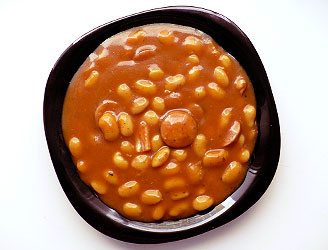
Jajecznica z kurkami i boczkiem • Scrambled eggs with chanterelle and bacon
in Polish: as above
For decades, Poles have been serving scrambled eggs with chanterelle mushrooms. Admittedly, this is a flagship example of making a delicious dish with a refined taste, from something cheap and as one could say: trivial. If you have the chance to try Polish scrambled eggs with chanterelle mushrooms during any of your future breakfasts, I would frankly recommend that. Bacon is also a common ingredient, as well as chopped chives.
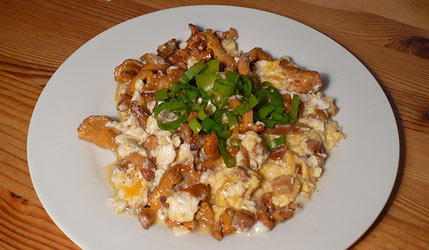
Nalesniki • Crepes / Polish pancakes
in Polish: naleśniki
Typical of many cuisines, Polish nalesniki are just pancakes with various fillings (from sweet to spicy). Nalesniki evolved from Old Polish pies and pancakes under the influence of French cuisine, and have been very popular in Poland for decades.
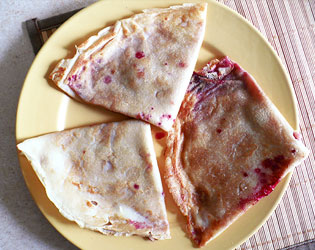
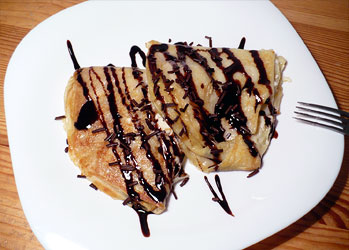
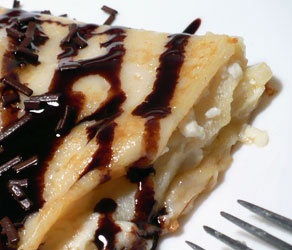
Ryz z jablkami • Rice with baked apples and cinnamon
in Polish: ryż z jabłkami
Rice with apples is a very simple, sweet Polish dish often present on Polish tables. It is made of cooked rice and some apples previously stewed with cinnamon. Sometimes cardamom or vanilla are also added. Another version of this dish is made of rice and apples that are baked in an oven rather than being boiled or stewed.
Pampuchy aka Kluski na parze • Greater Poland steamed dumplings
in Polish: as above
Pampuchy also known as bulki na parze (what simply means steamed rolls) are a kind of roll or a soft dumpling made from yeast cake. After steaming, pampuchy are dished up covered with sauces. Polish steamed dumplings can be sweet (stuffed with jam or fruit) or spicy (without the filling and poured with a meat sauce). Pampuchy are very similar to a highly popular and tasty national dish of Czech and Slovak cuisine – Knedlík, as well as German Klöße. It is a regional food of Greater Poland.
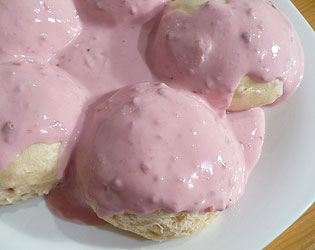
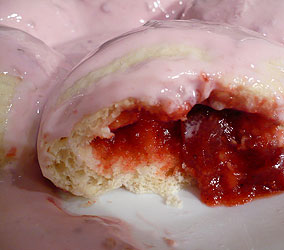
Kluski z serem • Pasta with sweet curd cheese
in Polish: as above
This is a very simple dish made from pasta and white cheese (Polish curd cheese) mixed with sugar and cream. This Polish food is served with an addition of jams or fruits.
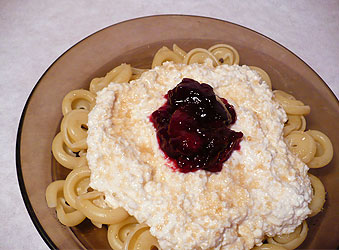
Kluski z truskawkami / jagodami • Pasta with strawberries / bilberries
in Polish: as above
Another simple but delicious summer Polish food made of pasta and strawberry or bilberry mousse (fruit mixed with cream and sugar).
